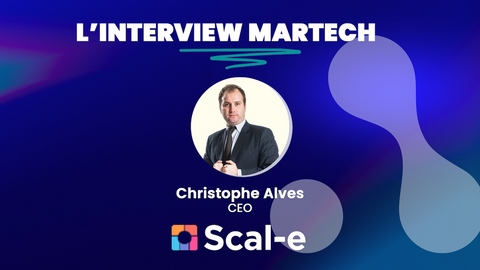As part of our Martech Insider Newsletter, we feature a marketing technology each month that deserves recognition. This month, we spotlight Scal-e, a bespoke customer marketing solution. Christophe Alves, CEO of Scal-e, presents his solution to us.
Hello Christophe,
How do you help brands? What do you offer?
Our mission is to help brands leverage their marketing data to create personalized customer experiences. We support them across the entire data value chain, from data collection to activation. With Scal-e, brands can unify their customer data, visualize and understand their audience, create precise segmentations and audience groups, design omnichannel customer journeys, send messages via desired channels (SMS, email, mobile wallet, print, etc.), and create personalized loyalty, engagement, or referral programs, all while maintaining control over data rules (privacy, marketing pressure).
What is your "Killer Feature"?
A custom-built datamart using a CDP based on client needs, directly within the tool without altering databases or requiring technical knowledge.

Does Scal-e integrate with other tools?
Yes, with ERPs, CRMs, POS systems, websites, mobile apps—any data source desired by the client.
Tell us about your client onboarding process.
During setup, we organize workshops on business and technical aspects to thoroughly understand the client's needs and the resulting technical applications. Initially, we provide training on the tool without considering the client's data. A second training session occurs 2-3 weeks later, once the client's data is on the platform, allowing the client to see how the software functions as they will use it in their office.
How is client and user support handled?
A knowledge base is available on the platform with articles on all software features. A support/CSM team is always available for free to advise on implementing client requests within the tool and to address any bugs, issues, or blockages on the platform.
How do you see the evolution of your market?
First, let's take stock:
- First-generation tools responding to the data explosion gave rise to numerous tools (CRM, ERP).
- The proliferation of these tools within client information systems created data silos, leading to the emergence of second-generation tools over the past 10 years that either connect to CDPs (via ETL) or natively integrate a CDP (as Scal-e does). The number and amount of acquisitions among major global publishers reflect this evolution.
- Now, as noted by Gartner, the market is already seeking third-generation tools. Having and unifying data is no longer enough. It's now essential to justify their origin, exercise consumer rights (forgetting, deletion, etc.) anywhere, anytime, and consider these rights in the treatments (statistics, marketing, or services) provided by the brand to customers.

This is why at Scal-e, we have developed a consent and privacy management engine directly plugged into our CDP. Simply indicating if a client is opt-in (or even a channel) is not sufficient to be GDPR compliant. This engine allows us to manage multiple regulations and ensure that local consumer rights, both Chinese (CDPR) and Californian (CCPA), are respected while enabling the brand to continue building global dashboards that do not exploit private data.
Moreover, as companies of all sizes and industries can benefit from a CDP today to improve their marketing and foster a more individualized relationship with their consumers, our clients and partners seek more autonomy in their daily operations and data visualization capabilities. Hence, a significant part of our development has focused on usage innovations, from UX to integrating reports/dashboards and currently launching advanced data visualization or custom dashboard features without needing an external BI tool.
Can you cite some use cases where Scal-e is recommended?
If a brand has various tools for marketing, commerce, and advertising that do not share data among themselves, the brand will lack the 360° customer profiles necessary for strategies like cross-selling, upselling, loyalty programs, increasing average basket size, purchase frequency, etc. Each tool will have its unique identifiers and data, leading to data silos. Implementing a CDP can unify these tools and create a unique, persistent identifier shared with all tools, transforming a siloed information system into a centralized one.
In the era of GDPR, CCPA, CDPR, e-privacy, and constantly evolving data privacy laws, brands and their DPOs want to ensure that marketing systems respect the consent upon which data was obtained. As CDPs control the data flow, they can help manage consumer data privacy. For instance, if a consumer provides data only for a transaction, the CDP must ensure no user data is used for marketing. Conversely, if a consumer agrees to receive a newsletter, they should be able to receive it.
A third common project, building on the previous two, involves activating unified data around user profiles to:
- Create audience segments and enter the era of mass personalization to offer tailored customer experiences.
- Create "lookalike audiences" of high-margin online buyers to acquire similar prospects on ad networks like Facebook and Instagram.
- Calculate KPIs like Customer Lifetime Value (CLV) to create a VIP loyalty program (top 20% of clients with the highest CLV) or increase the average CLV of each tier (silver, gold, platinum) by implementing the right reward strategy (discount coupons, exclusive offers, private sales, dedicated services).
- Calculate propensity scores to identify future buyers among clients or prospects by combining data on viewed content (website, email, in-store) and viewing frequency, for example, contacting prospects who have reviewed a product range or item at least three times in the last three days.
- Offer personalized product recommendations based on purchase history, selected products, or recently viewed items (e.g., if searching for a suit, suggesting a suit in the preferred color, blue, from a liked Italian brand) or complementary products (suggesting shirts, socks, ties, and shoes to go with the suit) to increase average basket value.
- Share content based on preferences (content type, medium (text, audio, video), channel) or a consumer's online and offline journey to boost engagement.
About Scal-e:
- Founded: 2007
- Offices: 6 (Paris, Toulouse, Barcelona, Bangkok, Miami, Shenzhen)
- Employees: Around 200
- Client Types: B2B, B2C, B2B2C, all sizes, and data marketing-oriented agencies
- Main French Clients: Mutualité Française, Arkopharma, La Boucherie, Bonpoint
Thank you, Christophe, for your time and the quality of your responses.
At SaaS Advisor, we have several successful missions with major groups and work with various market vendors. Want to learn more?
Another interview? Discover Beamy: A platform for governance of all SaaS software used within a company or group.
The Saas Advisor Team





